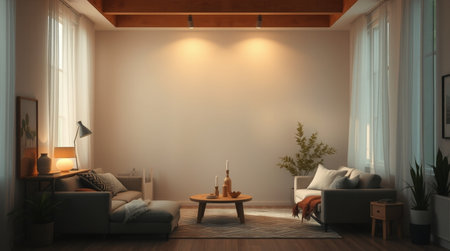Introduction: The British Desire for Beautiful Homes
Interior design holds a unique place in British culture, embodying much more than mere aesthetics—it is an expression of identity, aspiration, and tradition. From the ornate grandeur of Victorian terraces that line the streets of London and Manchester, to the sleek, minimalist appeal of contemporary flats in bustling city centres, the British have long had an enduring fascination with their living spaces. This cultural preoccupation is not just about keeping up appearances; it’s deeply rooted in history, reflecting a nation that values both heritage and innovation. Today, the trend of home makeovers has swept across the UK, fuelled by popular television programmes and glossy magazines promising affordable transformations. Yet beneath this veneer of accessible glamour lies a complex web of costs—financial, emotional, and practical—that are often overlooked. As we embark on this exploration from a distinctly British perspective, we’ll unravel how interior design has become intertwined with our sense of self and community, setting the stage for a deeper understanding of its hidden implications.
2. Beyond the Bill: Unobvious Costs Most Brits Overlook
When embarking on an interior design project in the UK, it’s easy to focus on visible expenses like furniture, paint, or designer fees. Yet, a distinctly British layer of hidden costs often goes unnoticed until they unexpectedly appear on invoices or council letters. Let’s delve into some of the most overlooked expenses—planning permission, building control fees, and the impact of VAT—that can significantly inflate your project’s bottom line.
Planning Permission: Navigating Local Authority Red Tape
Unlike in some countries, many UK home alterations require formal approval from your local planning authority. Whether you’re knocking through walls in a Victorian terrace or adding a loft extension in a Georgian townhouse, securing planning permission can be time-consuming and costly. Application fees vary by borough and scale of work; delays due to council backlogs are not uncommon, often leading to extended rental periods or storage costs as works are postponed.
Building Control Fees: Ensuring Legal Compliance
Once planning permission is secured—or deemed unnecessary—most structural changes require building control approval to ensure compliance with British standards. This involves inspections at various stages and certification upon completion. These fees are separate from those paid for planning and cannot be skipped; failing to obtain sign-off can affect property resale value and invalidate insurance policies.
Typical Hidden Fees Breakdown
| Expense Type | Average Cost Range (GBP) | Notes |
|---|---|---|
| Planning Permission Application | £200–£500+ | Varies by location and project size |
| Building Control Inspection | £300–£900+ | Depends on scope and number of visits required |
| VAT on Design Services (20%) | Variable | Applies to most professional fees and materials unless exempt |
The VAT Factor: Britain’s Unavoidable Tax
Value Added Tax (VAT) at 20% is levied on almost all goods and services related to interior design in the UK. While some may budget for the main contractor’s bill, it’s common to forget that VAT applies not just to labour but also to furnishings, fixtures, and even many specialist design services. For larger projects or listed properties, certain works may qualify for reduced rates—but these exceptions require careful documentation and advance planning.
Cultural Context: Why Brits Often Miss These Costs
The layered bureaucracy and variable fees embedded within the UK’s property improvement landscape are products of historical preservation concerns, safety regulations, and tax policy. Many Britons underestimate these costs due to lack of transparency in early project discussions or misconceptions based on overseas renovation shows that sidestep the realities of British legalities.

3. The True Price of Personalisation
In the UK, personalisation is often seen as the ultimate mark of a thoughtfully curated home. Yet, beneath the allure of tailored interiors lies a significant financial commitment. Bespoke furnishings—be it cabinetry, upholstery, or statement lighting—are rarely off-the-shelf purchases. Instead, they require skilled artisans and meticulous attention to detail, echoing Britain’s storied tradition of craftsmanship. Commissioning a local joiner in the Cotswolds or an upholsterer in Yorkshire not only ensures a unique result but also commands a premium price reflective of both labour and heritage.
These investments are more than mere expenditures; they are cultural statements. British tastes favour subtle elegance and enduring quality, with a nod to historical influences such as Georgian symmetry or Arts & Crafts authenticity. This preference drives demand for hand-finished materials, traditional joinery techniques, and fabrics from longstanding mills—a far cry from mass-produced imports. While this bespoke approach fosters a sense of place and identity within one’s home, it inevitably escalates costs.
Ultimately, when considering interior design in Britain, the true price of personalisation extends beyond aesthetics. It is about preserving national heritage, supporting local economies, and maintaining standards that have defined British interiors for generations. For homeowners seeking spaces that resonate with authenticity and character, these hidden costs are part and parcel of creating something genuinely bespoke.
4. Logistics, Delays, and the British Weather
When embarking on an interior design project in the UK, few anticipate just how profoundly logistics and the famously fickle British weather can affect both timelines and budgets. The reality is that lead times for furnishings, building materials, and bespoke fittings are at the mercy of supply chain fluctuations—a challenge exacerbated by Brexit, global events, and regional demand cycles. For many homeowners, understanding these hidden variables is crucial to avoiding costly surprises.
The Complex Web of Lead Times
Lead times are rarely straightforward. A sofa ordered from Italy or a unique tile sourced from Spain might sound romantic, but international shipping delays—especially post-Brexit—can stretch standard wait times from weeks to months. Even domestically produced items face bottlenecks due to high demand or material shortages.
| Item Type | Standard Lead Time (UK) | Potential Delays |
|---|---|---|
| Bespoke Joinery | 6-12 weeks | Material shortages, high demand |
| Imported Furniture | 8-16 weeks | Shipping disruptions, customs checks |
| Flooring Materials | 2-6 weeks | Weather, supplier backlogs |
The Unpredictable Influence of British Weather
The UK climate plays a surprisingly influential role in project schedules. Prolonged rainfall can halt building work, delay deliveries, or impact paint and plaster drying times. Seasonal shifts also affect when certain tasks can be tackled—exterior works or window installations may need to be rescheduled entirely due to inclement conditions.
Budget Implications of Delays
Every delay has a knock-on effect on your budget. Extended rental costs if you’re living elsewhere during renovations, additional storage fees for materials awaiting installation, and increased labour charges due to schedule overruns all add up quickly. It’s wise to build a contingency fund—commonly 10-15% of your total project value—to accommodate these unforeseen challenges.
A British Approach: Patience and Planning
Navigating these logistical hurdles with a characteristically British blend of patience and pragmatism will help you maintain perspective—and control costs—when the inevitable delays occur. Clear communication with suppliers about lead times, regular updates from contractors, and a flexible approach to scheduling will serve you well as you weather the storm of a typical UK renovation.
5. The Premium of Going Green
When it comes to interior design in Britain, sustainability is no longer a fleeting trend but an expectation. However, embracing eco-friendly principles often comes with its own set of hidden costs. Investing in sustainable materials—such as FSC-certified timber, recycled glass tiles, or low-VOC paints—means navigating higher price tags due to sourcing and certification processes that ensure genuine environmental benefit. These materials are frequently imported or produced in smaller quantities, which further drives up the cost for British homeowners seeking authenticity and traceability.
Beyond materials, energy-efficient installations such as triple-glazed windows, smart thermostats, and LED lighting systems are increasingly seen as essential features in modern British homes. While these investments promise long-term savings on utility bills and contribute positively to the environment, the initial outlay can be substantial. In heritage or period properties—a hallmark of the UK’s architectural landscape—retrofitting green technologies demands bespoke solutions, adding another layer of complexity and expense.
Moreover, acquiring eco-certifications such as BREEAM or the Passivhaus standard is both prestigious and costly. These schemes require rigorous documentation, professional assessments, and sometimes even redesigns to meet criteria. For British homeowners eager to showcase their commitment to sustainability, this means factoring in consultancy fees and additional project management hours on top of construction costs.
The drive towards greener interiors is undoubtedly shaping the future of British design, but it’s vital for clients to recognise that these choices carry a premium beyond the sticker price. By analysing these extra investments—from sourcing ethical products to securing respected certifications—homeowners can make informed decisions that align with both their values and budgets.
6. Maintenance and Legacy: Paying for the Future
While the allure of a freshly designed interior is undeniable, it is the ongoing costs—often overlooked—that truly define the long-term investment in your British home. Maintenance is a critical element, whether your property is an Edwardian townhouse or a modern eco-home in Surrey. High-quality finishes, bespoke joinery, and even period-correct paintwork all require regular upkeep to retain their charm and value. Skimping on maintenance not only diminishes aesthetic appeal but can lead to costly repairs down the line.
The British Insurance Perspective
In the UK, home insurance is more than a bureaucratic tick box; it’s a subtle art shaped by our unpredictable weather and storied architecture. Specialist cover may be required for heritage features like original stained glass or rare cornicing—items often omitted from standard policies. For new builds, warranties such as NHBC may offer peace of mind but rarely account for every eventuality. Understanding what your policy covers—and crucially, what it does not—is essential for financial planning.
Future-Proofing: The Unseen Price Tag
Whether safeguarding a cherished Victorian terrace or integrating smart technology into a minimalist loft, future-proofing comes with its own hidden costs. Modern expectations around sustainability, accessibility, and technology integration mean today’s design choices must stand the test of time—both aesthetically and functionally. Retrofitting insulation into solid brick walls or rewiring for evolving tech standards are investments that rarely make it onto initial budgets.
The Legacy Mindset
Ultimately, interior design in Britain isn’t just about present-day pleasure; it’s about stewardship for future generations. Every decision—from materials to maintenance contracts—contributes to your home’s legacy. These hidden costs may not carry the glamour of velvet sofas or encaustic tiles, but they’re intrinsic to preserving both financial value and cultural heritage.
7. Conclusion: Making Informed Choices in the UK Market
As British homeowners navigate the nuanced world of interior design, it becomes imperative to look beyond the surface-level appeal of upfront savings. While cost-effective options can seem enticing, true value emerges from a well-informed approach that factors in long-term durability, maintenance, and the genuine quality of both materials and craftsmanship. In the UK context—where property values are often closely linked to the standard of interiors—transparency is not merely a virtue but a necessity. Homeowners are encouraged to engage openly with their designers, ask detailed questions about every stage of the process, and request clear breakdowns of costs. Furthermore, seeking out accredited professionals—such as members of the British Institute of Interior Design (BIID) or those holding relevant industry certifications—can provide an added layer of reassurance and accountability. Ultimately, by weighing short-term savings against lasting investment and embracing a culture of openness, British clients can ensure their interiors stand the test of time and add meaningful value to their homes.


